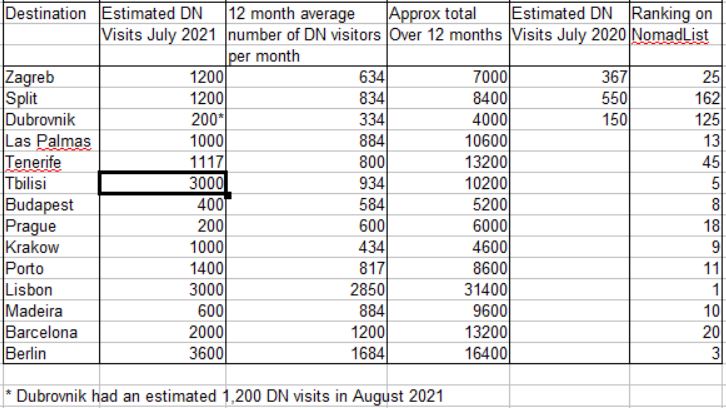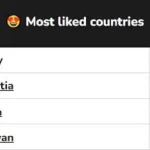The first statistic I came across when I started writing about the digital nomad opportunity in Croatia over two years ago was that there would be one billion digital nomads in the world by 2035. This was before the major shift in work patterns brought on by the pandemic, and looking back, I think it referred to remote workers (people working remotely, including at home), rather than digital nomads (those who up sticks and move around, usually to other countries). If the number was a billion before the pandemic, I wonder what it is now.
That vague number has been followed by other vague numbers. Just how many digital nomads are out there, and how many are actually travelling during the pandemic? And where to?
There are, of course, some ways to track some data. The number of applications and approvals for the Croatian digital nomad permit, for example. But this only tells part of the story (the number of people outside the EU who want to commit to living 12 months in Croatia and go through the bureaucratic process during a pandemic). Much more popular (and evident from the various dedicated forums and social media groups dedicated to the subject) is a stay of 1 – 3 months. Finding out accurate data on those numbers is a much harder task, as nomads rarely register themselves as such and so are not easily tracked.
One of the most interesting things I learned about the changing patters of tourism back in May was that in the first 4 months of 2021, more than 25% of AirBnB bookings were for 28 days or more. A good number of those would be worcations, I am sure, with many a digital nomad included therein.
One thing is clear. The future of remote work has arrived, and the trend to live and travel on the road is only going to grow. And once the pandemic is over, and this trend is more mainstream, then it will become a sizable part of some national economies. As I and others have been advocating for some time now, this represents a great opportunity for Croatia. The recent CNBC news feature by American Steve Tsentserensky showcases the financial and lifestyle attractiveness of life in Dalmatia, while showing how a regular nomad pumps US$17,000 into the Croatian economy in 12 months, while also promoting the country for free (the video above has been viewed more than 200,000 times already).
Tsentserensky is one of the 86 approved Croatian digital nomad permit holders, following his successful application after reading about it on TCN. But if less than 100 visas have been issued so far, does that mean that no digital nomads are visiting Croatia?
Far from it!
Nomad List, arguably the leading global digital nomad resource, compiles extensive data on more than 300 DN destinations around the world, including estimated statistics of visitors to a destination by month, year and weighted monthly average. These statistics can be extrapolated from the site. Before we continue, a word on how the data is calculated:
Values shown are estimated visits by traveling remote workers based on the total amount of trips logged by Nomad List members. Visits to a place are only counted once per year per user, even if they visit more in that year. Not all nomads are on Nomad List, and not all Nomad List members log their trips. So the data is only indicative.
But while the numbers may be indicative, the method of calculation is the same across the board for all destinations. This allows us to see how Croatian destinations are performing against other more established destinations. And the results are MORE than a little encouraging, both in the numbers and rising trends for Croatian destinations.

The first piece of good news is that Zagreb is currently ranked 25th as a global digital nomad destination, with an overall ranking of 4.09/5 from 234 reviews, quite an achievement for the Croatian capital, which started its digital nomad campaign with Zagreb Digital Nomad Week back in June. There are three other Croatian cities in the top 200 – Dubrovnik (125), Split (162) and Osijek (165 – no traffic data currently available). This is a higher number than established Canary Islands DN hot spots such as Las Palmas and Tenerife, and almost on a par with the likes of Porto.
And when it comes to Central and Eastern Europe, both Split and Dubrovnik are proving more popular than Prague, Krakow and Budapest (the latter admittedly more affected than most by the lockdown).
Even more encouraging for all three destinations is the rise of the 12-month average number of digital nomads compared to a year ago, with the trend for all Croatian destinations heading the same way. While Zagreb averaged 367 visitors a month when the visa was announced a year ago, that number today is 634. Split was 550 and today is 834, and Dubrovnik too is rising – from 150 to 334.
Both Zagreb and Split had an estimated 1,200 DN visits in July (Dubrovnik has the same in August), according to the NomadList data.
Data from two other destinations caught my eye. The Georgian capital , Tbilisi, is among the most popular places in Europe, with a marked rise in visits. Apart from being a great destination (I lived there back in 1995), it also has a visa and is very competitive on price.
And Madeira also has an interesting digital nomad story, having achieved global interest this Spring with the launch of the world’s first digital nomad village. While that provided a huge spike of interest, this seems to have dropped off a little, and its monthly average numbers are similar to Split, which has yet to do anything major in terms of digital nomad promotion.
These numbers, while encouraging, are still small. There are many challenges along the way, not least the pandemic and getting Croatia’s message out there. But the data suggests that the foundations are solid, and a dividend from the huge free PR from the digital nomad permit story is already bearing some tiny fruit. A very solid base on which to build.
For more news and features about digital nomads in Croatia, follow the dedicated TCN section.











